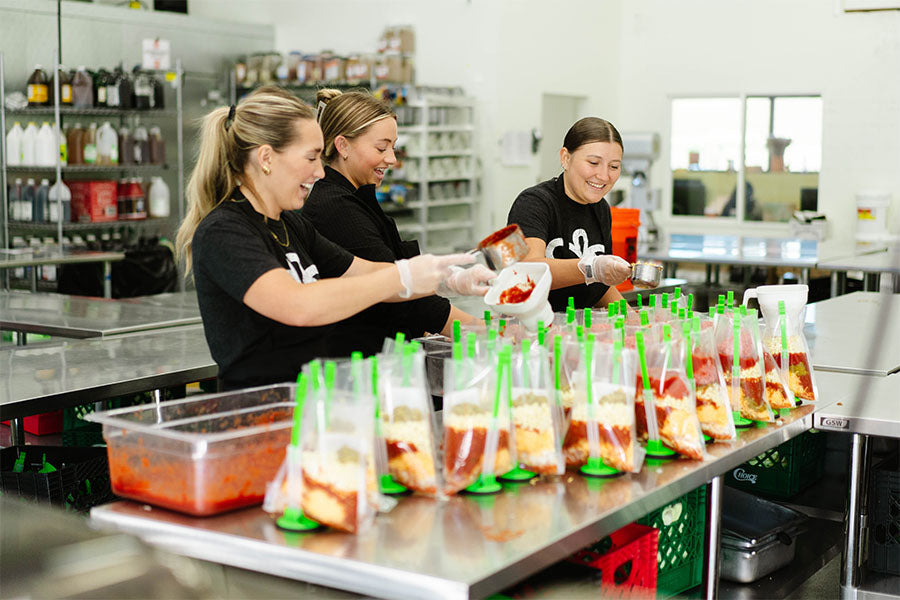How Much Do Groceries Really Cost in 2025?

A Look at National Averages, State-by-State Prices, and How Meal Prep Can Help
With inflation and the rising cost of living, one question is top of mind for families across the country: Why are groceries so expensive right now? Whether you're feeding a family of five or managing meals for one, the weekly grocery bill feels heavier than ever. Here's what you need to know about the average cost of groceries in 2025 — and how meal prep can help ease the burden.
The National Average: Grocery Spending Hits $900+ per Month
A recent Popmenu survey found that the average American is now spending $235 per week on groceries — that’s more than $900 per month per person. This marks a significant jump from 2024 levels and underscores the mounting pressure on household budgets. [Investopedia]
Food-at-home prices have increased 2.3% year-over-year as of mid-2025, according to the Bureau of Labor Statistics. [BLS.gov] Food inflation overall is sitting at around 2.4%, with some categories seeing even steeper hikes.
Why Grocery Prices Are Rising
According to the USDA’s Food Price Outlook, categories like eggs (+27%), beef and veal (+10.6%), and non-alcoholic beverages (+4-5%) have seen the largest price increases. [USDA]
This isn't just a result of supply chain disruptions. Ongoing labor shortages, extreme weather patterns, and rising fuel costs are all contributing to food price inflation — and consumers are feeling it.
Grocery Costs by State: Who Pays the Most?
Where you live significantly impacts how much you spend. Some states pay hundreds more per month than others due to shipping costs, local tax structures, and access to affordable retailers.
| State | Avg. Weekly Grocery Cost | Avg. Monthly Cost | Details |
|---|---|---|---|
| Hawaii | $333.88 | $1,446 | Highest cost in U.S., driven by import/shipping expenses World Population ReviewDelish |
| Alaska | $328.71 | $1,418 | Remote geography inflates pricing World Population Review |
| California | $297.72 | $1,288 | High cost of living & environmental/regulation impacts World Population ReviewInvestopedia |
| Nevada | $294.76 | $1,277 | Southwestern metro pricing higher than national average World Population ReviewHelpAdvisor |
| Mississippi | $290.64 | $1,259 | Among lowest absolute costs but highest share of income spent (~2.6%) World Population Reviewwallethub.com |
| Washington | $287.67 | $1,243 | Pacific Northwest pricing elevated HelpAdvisor |
| Florida | $287.27 | $1,243 | Warm‐climate regions often slightly above average HelpAdvisor |
| New Mexico | $285.71 | $1,234 | Southwest state cost near average worldatlas.com |
| Texas | $285.71 | $1,234 | Large state, wide variation; average is near national level worldatlas.com |
| Louisiana | $283.33 | $1,225 | Lower-than-average within South worldatlas.com |
| Colorado | $280.00 | $1,209 | One of the smaller 12‑month hikes (~2.9%) worldatlas.comconsumeraffairs.com |
| Oklahoma | $279.00 | $1,207 | Generally moderate cost region worldatlas.com |
| Georgia | $278.00 | $1,202 | Southern-average pricing worldatlas.com |
| Utah | $278.00 | $1,202 | Slightly below average for mountain‑west states worldatlas.com |
| New Jersey | $275.00 | $1,183 | Bordering expensive metro impacts; relatively lower income share (~1.5%) worldatlas.comwallethub.com |
| Alabama | $272.00 | $1,178 | Roughly in line with national; relatively lower income burden worldatlas.com |
| Arizona | $272.00 | $1,178 | Moderate consumer inflation (~3.3%) worldatlas.comconsumeraffairs.com |
| Massachusetts | $272.00 | $1,178 | Inflation around 6.6% year-over-year; urban/regulation pressures worldatlas.comconsumeraffairs.com |
| Tennessee | $270.21 | $1,080 | Exactly national average by definition Delishvisualcapitalist.com |
| Illinois | $269.00 | $1,167 | Midwestern blend just under national worldatlas.com |
| Connecticut | $266.00 | $1,146 | Tied with MD, NY, NC—state/metro mix raises costs locally worldatlas.comHelpAdvisor |
| Maryland | $266.00 | $1,146 | Similar to Connecticut; ~7% YOY inflation worldatlas.comconsumeraffairs.com |
| New York | $266.00 | $1,146 | High-density urban cost; statewide average moderate worldatlas.comnypost.com |
| North Carolina | $266.00 | $1,146 | East Coast average; inflation ~6.4% worldatlas.comconsumeraffairs.com |
| North Dakota | $265.00 | $1,146 | Among lowest 12‑mo price hikes (~6.4%) worldatlas.comconsumeraffairs.com |
| Arkansas | $261.00 | $1,130 | Low prices but high income share (~2.5%) worldatlas.comwallethub.com |
| Virginia | $260.00 | $1,127 | Moderate-cost Mid-Atlantic; ~3.6% inflation worldatlas.comconsumeraffairs.com |
| Idaho | $258.00 | $1,117 | Mountain/West average-line pricing worldatlas.com |
| Nebraska | $235.12 | $1,020 | Low-cost Plains state HelpAdvisor |
| Iowa | $227.32 | $986 | Among lowest, consistent Midwestern savings HelpAdvisor |
| Wisconsin | $221.46 | $957 | Lowest average weekly cost nationwide HelpAdvisornypost.com |
Even in lower-cost states, grocery spending can eat up a disproportionate amount of a family’s income — especially in states with lower median wages. Households in Mississippi, for example, spend nearly 2.64% of their annual income on groceries, the highest share in the country. [Food & Wine]
How to Fight Grocery Inflation with Smart Meal Prep
Here’s the good news: you can fight back against rising prices with a few simple strategies — and meal prepping is at the top of the list.
1. Batch Cooking & Freezer Meals
Prepping meals in advance helps reduce last-minute trips to the store (and the impulse buys that come with them). Slow cooker meals, in particular, can help stretch proteins and vegetables across multiple servings.
2. Shop Sales & Choose Generic
Research shows that shoppers can save up to 30% just by opting for store-brand goods and shopping based on weekly promotions. [Investopedia]
3. Consider Dietary Swaps
Believe it or not, some diets can be significantly more affordable. A recent report found that vegetarian households save an average of $130 per month compared to unrestricted diets. [Food & Wine]
4. Limit Food Waste
By prepping exact portions and freezing leftovers, families can avoid tossing out spoiled produce or uneaten meals — a key driver of waste and wasted dollars.
The Bottom Line
Food costs are high — and rising — but that doesn’t mean you’re powerless. By understanding where your state ranks and making simple changes in how you shop, prep, and cook, you can take back control of your grocery budget.
At Beehive Meals, we’re passionate about helping families simplify dinner without sacrificing quality or nutrition. Whether you’re feeding kids, caring for aging parents, or just trying to make ends meet, meal prep isn’t just a convenience — it’s a solution.
Frequently Asked Questions About Grocery Costs in the U.S.
1. What is the average weekly grocery cost in the United States?
The average American household spends approximately $270.21 per week on groceries, according to a 2023 analysis by HelpAdvisor using U.S. Census data. This adds up to about $1,080 per month for a typical household. Keep in mind that this can vary significantly based on location, household size, and dietary preferences.
2. How much do groceries cost per person in the U.S.?
According to a national survey cited by Investopedia, the average person spends about $235 per week on groceries. This figure is based on self-reported data and may include extras like snacks, beverages, and meal kits. It's helpful to compare this with household-level spending to get a clearer picture of actual costs.
3. Which U.S. states have the highest grocery costs?
Hawaii, Alaska, and California rank among the most expensive states for groceries. For example, the average household in Hawaii spends over $1,500 per month on groceries. Higher transportation costs, geographic isolation, and limited local food production drive these prices up.
4. Where are groceries the cheapest in the U.S.?
States like West Virginia, Arkansas, and Iowa tend to have the lowest average grocery bills. Households in these states spend as little as $770 to $850 per month, thanks to a lower cost of living, more accessible local food sources, and reduced shipping costs.
5. How has inflation impacted grocery prices in 2025?
Grocery prices have risen significantly due to inflation, supply chain disruptions, and increased labor costs. In many regions, food-at-home prices have gone up 6 to 9 percent year-over-year. As a result, families are looking for cost-saving strategies like meal planning, bulk buying, and freezer meals to better manage their budgets.




